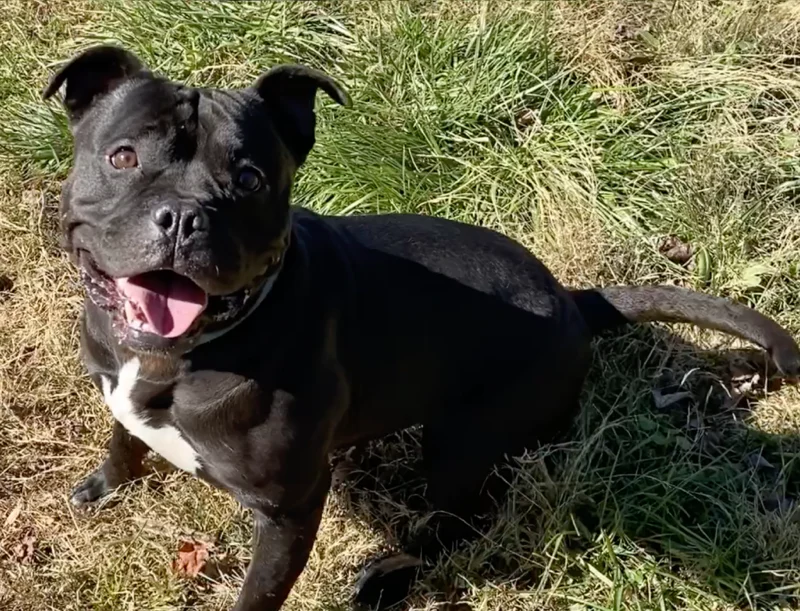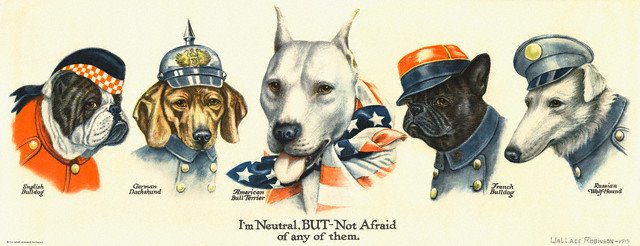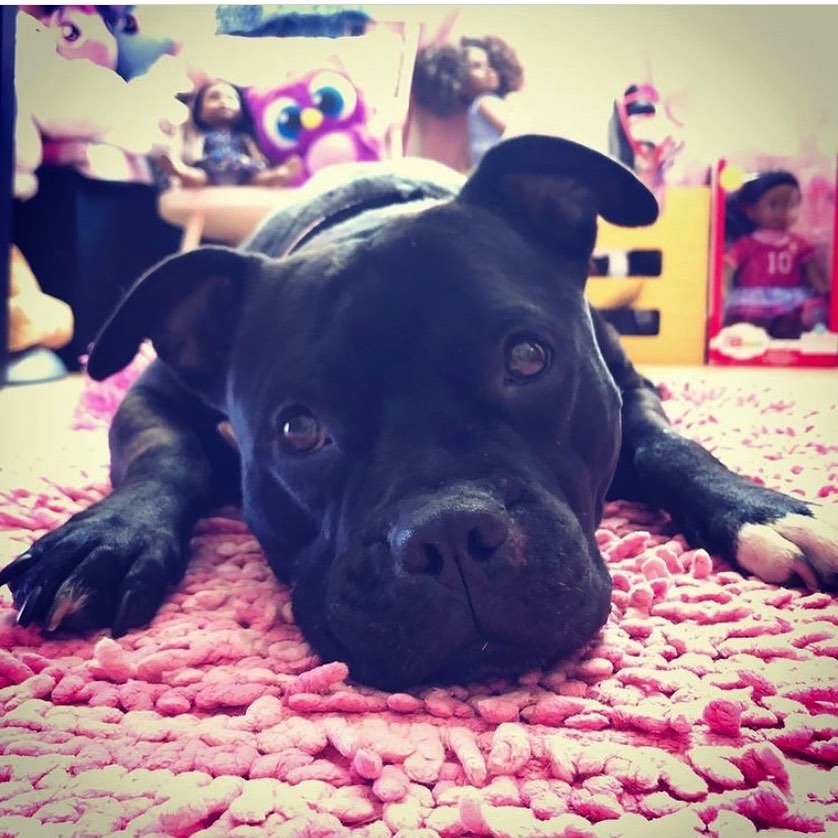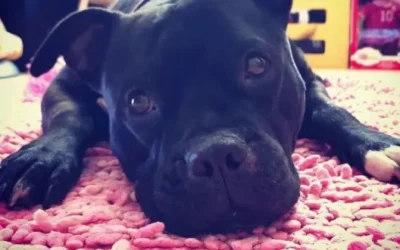
If a dog spends over a year at a shelter, watching patiently as the dogs around her come in and out every few weeks, you can be pretty sure the dog has some medical or behavioral challenge that makes it necessary for the shelter take extra time to find the “just-right” adoptive family.
Or maybe it’s just because she’s a pit bull.
Shelter life is a challenge for any dog– for reasons that are probably not hard to imagine– but pit bulls have it even harder. There’s one particular dog that brings the whole issue into focus for me, and that’s a dog named Bijou.
Bijou arrived in late 2018 from another shelter. She quickly gained fans among the volunteers for her cheerfulness and her enthusiasm for play. She was healthy, and at about five years old wasn’t so old that potential adopters shied away. She made friends easily. We had a lot of fun afternoons running around in the field, and this dog loved a Kong like no dog I’ve ever met. As for her adoptability, though, Bijou had two strikes against her. One is that, frankly, she’s not really into dogs.
Some dogs just don’t like other dogs. They like hanging out with their people, and don’t really have much use for dog-friends. The reason why this is such a big deal for a dog like Bijou is that often in the shelter, when we have a long-time resident as well-liked as Bijou, eventually one of the volunteers adopts her. But the catch is that most volunteers, if their circumstances allow it, already have one or more dogs at home! Many of Bijou’s fans, myself included, just couldn’t take this dog home with them.
The other reason that Bijou remained at the shelter, month after month, is that she is a pit bull, and life isn’t easy if you’re a pit bull. Many people fear you, and even if they don’t, they have to deal with friends, relatives and/or landlords who do. About ten months into Bijou’s stay in the rescue, I had the chance to show her to a great family that was looking for a playful dog. They all got along great during the “meet” and it looked like she had finally found her “furever” home. Later, though, there was bad news… the family told me that they were avid campers, and they learned that a pitbull would not be welcome in a lot of the places they go.
Back to the kennel she went.
Pit Bull: America’s Dog

It wasn’t always that way. For most of the breed’s history, pitbulls (which is actually a collection of several breeds: the American Pit Bull Terrier, the American Staffordshire Terrier, Staffordshire Bull Terrier, and a few others) were neither shunned nor feared the way the are today. Indeed, it would be easy to make the argument that the pitbull is “America’s Dog”. In the 1920s and 30’s, one of the most famous dogs in the country, Petey, was a pitbull (actually, two), as was Buster Brown’s trusty sidekick. Pitbulls weren’t fancy, but Americans tend to reject anything that seems too fancy, anyway.
To illustrate the pit bull’s place in the American pantheon, you can see how often it appeared as a symbol of America during the world wars. While Germany was often portrayed by the dachshund and England the bulldog, no dog better suited America than the pit bull: no ifs, ands, or buts about it. (As a historical footnote, dachshunds were treated horribly by Americans during the wars, with the little dogs sometimes being beaten or poisoned by those who felt the little twenty-pound dogs posed a clear and present danger to the nation. At the same time, the German Shepherd Dog was renamed –temporarily– “Alsatians“, or just plain “Shepherd Dogs”.)

Theodore Roosevelt had a pitbull, named “Pete” in the White House, but I won’t go into that particular case because Pete wasn’t exactly the model of good behavior. All I can really say is that, like people, all dogs are individuals and just as there isn’t anything about a pitbull that makes them somehow worse than other dogs, there also isn’t anything about a pitbull that makes them somehow better. So, let’s carry on.
Not the original “bad dog”
For a generation now, pit bulls have carried the stigma of aggressive, dangerous dogs, so it’s hard to imagine that fifty years ago, they were safely outside of society’s crosshairs.
In fact, the first widespread breed-loathing in this country occurred in the late 19th century, and involved “spitz-type” dogs, a group that includes Huskies and Pomeranians, and stems from some dubious scientific claim that they were particularly susceptible to (carrying) rabies. This panic resulted in the widespread destruction of spitz-type dogs and breed-specific legislation, many of the same things we see today in regards to the pit bull.
Pit bulls didn’t begin to get their bad reputation until the 1970’s. Beginning in that decade, the American people became increasingly fearful of violent crime. Whether the country did actually become more dangerous during this time or whether this was just a mass hysteria (or a combination of the two) no longer matters; Americans were convinced that violent crime was on the rise, and they were afraid. Fearful Americans sought dogs to accompany them for protection.
For the well-to-do, the German Shepherd Dog was the protection dog of choice. (Notably, German Shepherd Dog bites outnumber pit bull bites in most tallies, but it is widely recognized that bite data is woefully poor as a whole and shouldn’t be relied upon.) The less-moneyed gravitated toward pit bulls which were smaller than GSDs, less costly to keep up, and easier to keep on a smaller property or an apartment. It goes without saying that in America, the less-moneyed classes also tend to be the minorities.
Once the pit bull became associated with the poor and minorities, it became easy to use discrimination against the dogs as a convenient proxy for discrimination against their people. It may be illegal (and, in most circles, socially unacceptable) to refuse to rent an apartment to certain colors of people, but society considers it perfectly OK to refuse to rent an apartment to an owner of a pit bull, which statistically speaking is more likely to be a minority or member of the lower classes.
Embracing the stereotype
At this point, we begin to enter a cycle, when popular culture begins to embrace the bad-boy characterization of pit bulls. Some people took on pit bulls as pets precisely because they were considered dangerous, and encouraged their dogs to be aggressive. The pit bull became the dogfighting icon, and even though it has been a long time since there have been a substantial number of fighting dogs in this country, the perception has been cemented. Google the phrase “pit bull logo” and witness the preponderance of spiked collars and snarls. Increasingly, dog bite stories in the news tended to identify the biting dog as a pit bull despite very sketchy background information (“witnesses may be predisposed to assume that a vicious dog is [a pit bull]”).

Breed-specific legislation — with no foundation in reliable data — targeted pit bulls in a number of American cities, and are only recently being rolled back as we, as a nation, begin to realize the flimsy rationale and bad data behind them. In 2020 the people of Denver to vote to lift a pit bull ban that costs the lives of thousands of dogs — dogs that had no history of aggressive behavior. The ban had been in place for thirty years.
Although America is far from being able to free itself from widespread racism, there are very few places in this country one can openly embrace racism without becoming a social pariah. Not so with prejudice against pit bulls. People who pride themselves on their commitment to racial harmony and fairness in this country have no problem singling out one breed of dog (often based solely on appearance) and declaring them to be worthy of death. And America is not alone. Just last week in the UK, a dog who, in the words of the judge overseeing the case, has an “excellent temperament” and was not known “ever to have shown aggressive or dangerous behaviour”, will be put down because he is a pit bull-type dog, one of the breeds specifically impermissible under Britain’s Dangerous Dog Act.
The legacy
Even in the “woke” 2020’s, the discrimination we show against pit bulls is appalling. Pit bulls spend years in shelters hoping to be adopted, either because people fear them or do not want to take on the societal baggage associated with owning a pit bull.
Thankfully, there are still people out there whose minds are a bit more open. Around Christmas time last year, a family — parents with two small children — came to the shelter to visit with the dogs. They had recently lost their family pet, they said, and although they were not looking to adopt another just yet, they thought the kids would enjoy giving treats to some of the shelter dogs and brightening their day.
Then they met Bijou.



Leave a Reply